The city of Pushkar, India, is a place steeped in history, culture and spirituality. Surrounded by hills and bathed by the waters of the sacred lake of the same name, Pushkar is considered one of the oldest cities in Rajasthan. Every year, thousands of pilgrims head here to immerse themselves in religious traditions and participate in the famous Pushkar festival. At this considerable livestock fair, camels are bought and sold. Among the cities I loved most on my trip to India, Pushkar has a unique atmosphere steeped in adventure and religiosity.
Table of Contents
What to see in Pushkar, the holy city of Rajasthan
During my trip to Rajasthan, the city of Pushkar left an indelible impression on me. This authentic place is still immune to mass tourism. It still offers a genuine experience, an immersion in the true essence of India, between commerce and religion.
PLAN YOUR TRIP TO INDIA
When in India, stay connected at the best rates by purchasing an Airalo eSIM online before your trip. This eliminates the hassle of purchasing a physical SIM at the airport.
About travel insurance, Heymondo is the way to go. They offer comprehensive coverage against unexpected events like medical emergencies, trip cancellations, lost luggage, and more. Heymondo provides excellent value for money and will give you peace of mind on your travels!
Pushkar is considered a holy city due to the presence of the Brahma Temple, one of the few in India and the oldest dedicated to this deity. Every evening, pilgrims take part in the evocative Aarti ritual. During the day, you can instead climb the nearby mountain to go to the Temple of Savitri Devi, dedicated to the god’s consort.
The city’s beating heart is the Pushkar Lake. To be honest, it is not pretty to look at, due to the piles of rubbish that seem invisible to pilgrims and residents (but it is like that everywhere in India). To maintain a pure and spiritually elevated atmosphere, the sale and consumption of alcohol and meat are prohibited throughout the city. You will only find vegetarian restaurants and cannot even drink beer in luxury hotels. However, despite appearances, Pushkar is not just about religion and spirituality.
Once a year, the city changes its face and fills with visitors, attracted by the famous Pushkar Festival. It is a lively livestock fair that also attracts Western tourists, mainly from Spain, France, and Israel, attracted by both the event and the availability of opium.
With its contrasts, Pushkar is a city that does not go unnoticed. Whether looking for the liveliness of a cattle fair, a spiritual journey or simply a cultural discovery, visiting Pushkar offers you the opportunity to connect with ancient traditions and breathe in a unique energy.
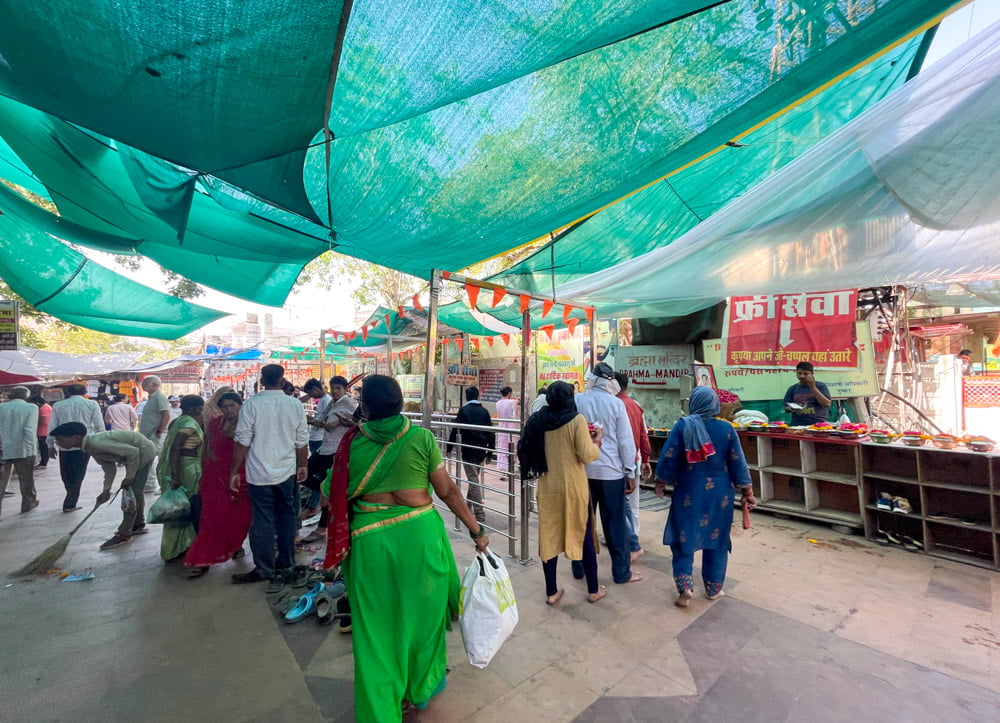
The Holy Lake of Pushkar: legends and religious significance
The Holy Lake of Pushkar in Rajasthan is shrouded in a legendary religious aura. According to Hindu tradition, it originated from a lotus flower Brahma threw to defeat a demon. The lake is also associated with other myths and legends, such as Shiva’s Tears. Every year, pilgrims and devotees gather in Pushkar to participate in the Aarti ritual in the Brahma Temple, making the place of great spiritual importance.
For believers, bathing in the waters of Pushkar Lake can purify the soul, bring spiritual blessings, and cure skin diseases. That’s because King Nahar Rao Parihar, who lived in the 9th century and built the 52 ghats, the steps where worshippers prepare for diving, was cured of vitiligo after dipping his hand in the sacred waters.
There are more than 500 Hindu temples around Pushkar Lake, each with its own history and spiritual significance. The most visited is undoubtedly the Brahma Temple, the most important temple dedicated to this deity. It is a place of deep devotion and spirituality for Hindus.
Unfortunately, mass tourism and deforestation nearby have caused considerable damage to the lake. Although the local government is taking conservation measures, rubbish is floating along the shores of the lake, a common problem in most of India. Although it may seem strange to you, Indian pilgrims do not consider it a problem to bathe in the polluted waters and unhesitatingly join the other worshippers on the ghats, keeping their faith and devotion intact.
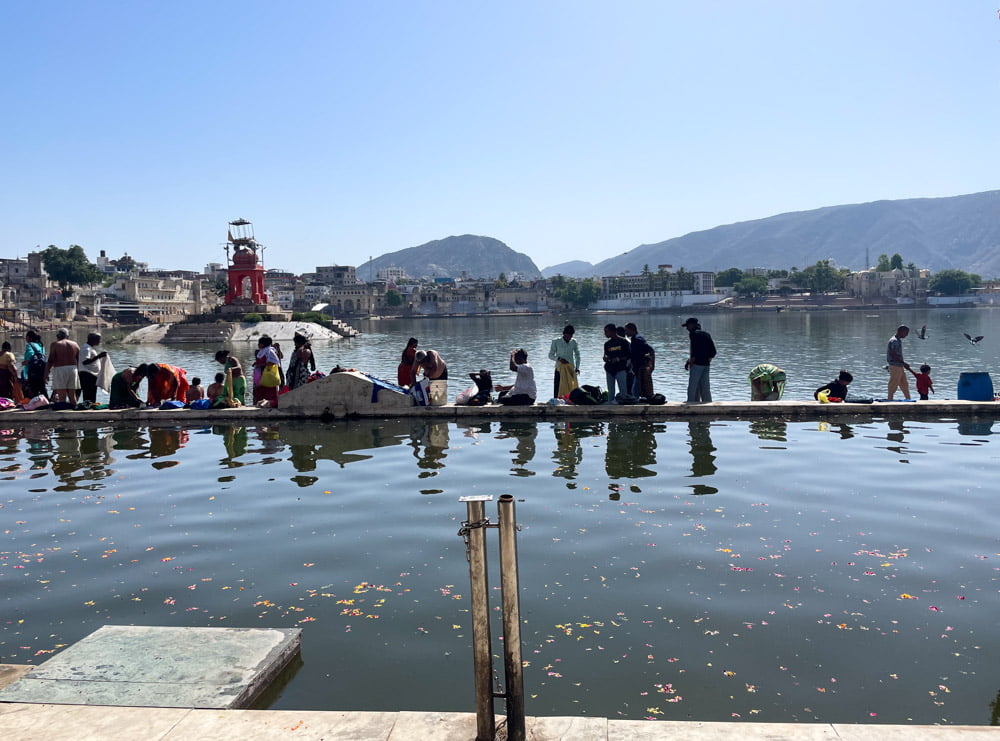
The Brahma Temple: the most important place of worship in India
The Brahma Temple in Pushkar, also known as the Jagatpita Brahma Mandir, is a holy place of great importance in Rajasthan. According to legend, the temple was created directly by the god Brahma. It is one of the few temples dedicated to him in India. A TripAdvisor certificate of excellence, displayed in plain sight, recognised the Brahma Temple in Pushkar as the ‘best temple ever’.
Like many other temples in India, the Brahma Temple in Pushkar stands on an elevated plinth, accessible via a flight of steps. Worshippers must follow an obligatory path that leads them to the open-air hall called mandapa, surrounded by columns. From here, they can watch the Aarti ceremony in the next room, the garbhagriha, with an open side facing the crowd.
On the way to the temple and along the entrance, the streets are dotted with stalls selling offerings for the deities. These include bowls with flowers, glitter stickers, sugar candies, edible seeds and coloured powders to draw the typical dot on the forehead. However, most of these offerings are thrown away after being presented at the temple without considering the environmental impact.
In India, however, everything is really so sloppy. For instance, in this temple, as in the others we visited, to enter, you have to leave your shoes and cameras in dedicated spaces, guarded by a person without any recognition, to whom you have to leave a tip. Yet, although unofficial, this system works, but I would not trust leaving valuables. Perhaps that is the charm of India, to see how things work despite an apparent lack of logic.
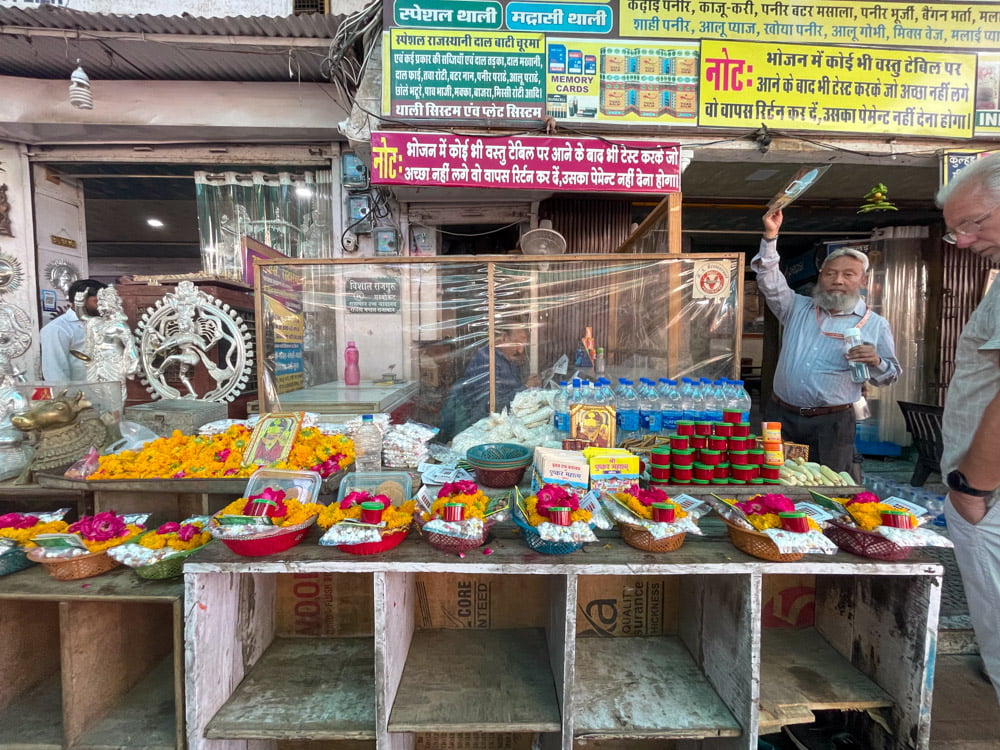
The Aarti ritual at the Brahma Temple
An activity not to be missed in Pushkar is participating in the fascinating Aarti ritual held every evening in the Brahma Temple. The sacred ritual has been held continuously for centuries. It involves offering camphor flames to the deity Brahma through a five-mouthed lantern, a symbol of purification and sacredness.
The Brahma Temple is particularly crowded on this occasion, with many worshippers queuing to enter. We were in the front row only because our guide had accompanied us well before the start of the ceremony. During the ritual, the Brahmin, the temple priest, leads the ceremony by chanting mantras. At the same time, the faithful fervently accompany the ringing of the bells by incessantly clapping their hands.
As you immerse yourself in the crowd, you may feel a mix of emotions that are difficult to comprehend. However, being in the midst of it all is truly enchanting. This experience, much like any other in India, is one-of-a-kind. On one hand, it may appear out of place and pointless, yet on the other, it bears witness to the potent mystical energy that permeates this land.
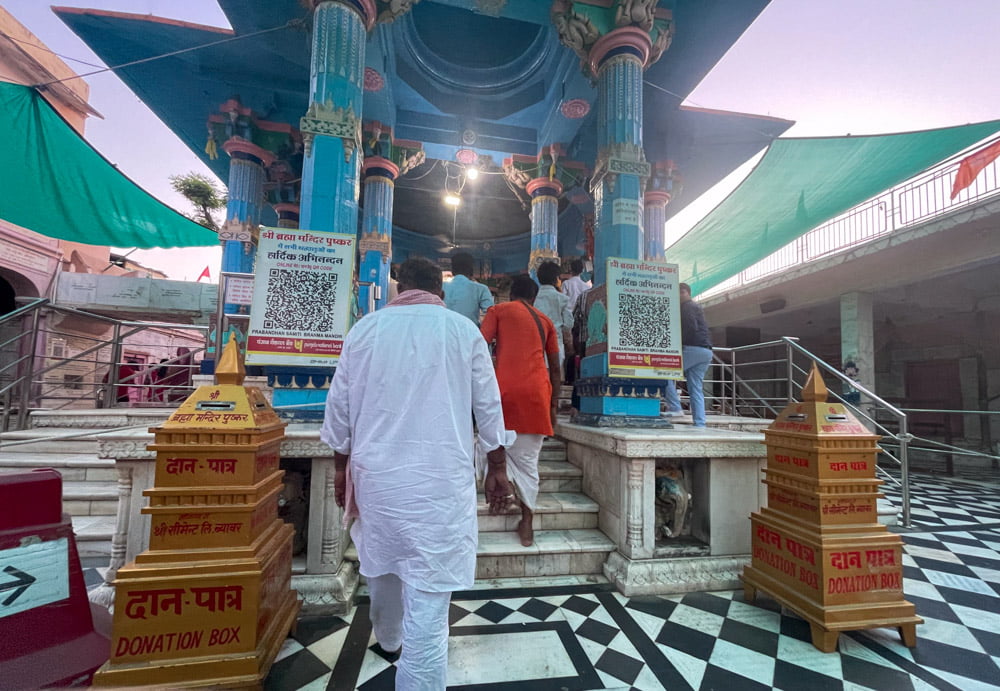
Savitri Devi: the temple on the mountain dedicated to Brahma’s wife
Another incredible Hindu temple in Pushkar is the one dedicated to Savitri, Brahma’s wife, located on Ratnagiri Hill. You can only reach the Savitri Devi Temple via a 970-step staircase under the sun or a cable car suspended in the void.
With my group of friends, we tackled the cable car. Still, I don’t recommend it if you fear heights because it goes through eerie gorges with rocky outcrops. However, once you reach the top, any fear or fatigue experienced in getting to the top is erased by the extraordinary view of the city of Pushkar and the surrounding hills.
The temple is perched atop the hill, with colonies of monkeys crowding the stairs and the cable car structure. Seeing them in the wild is really exciting. The temple, on the other hand, with free admission and open every day, has a classic Hindu structure with an open space for worshippers and an enclosed room that houses the deities’ statues. Here, the goddess Savitri stays in the centre, flanked by the goddess Sharda on the right side and the goddess Saraswati on the left side.

The Pushkar Festival: the city’s most important annual event
In addition to its religious importance, the city is famous for the Pushkar Festival, which includes the famous cattle and camel fair. The festival date varies yearly according to the lunar calendar but usually falls between October and November. During this period, the city is transformed, with visitors from worldwide attracted by the festival’s fame.
The Pushkar Cattle and Camel Fair is one of the largest in India and attracts almost 200,000 visitors annually. A tenth of these are international tourists, attracted by the lively bazaar and the chance to immerse themselves in the local culture. Most of the tourists at this time are Spanish, French and Israeli. There are so many tourists from Israel that a curious Israeli restaurant stands out in the centre of Pushkar, seemingly out of context.
The Pushkar Festival traditionally starts with a camel race, followed by musical performances, traditional dances and demonstrations of the skills of camel drivers, who climb on the backs of camels to show their mastery. During the fair, the shores of Pushkar Lake are crowded with thousands of people. The men trade camels, horses, cows, sheep and goats. On the other hand, women from rural areas shop for bangles, traditional clothing, textiles and high-quality fabrics at the various handicraft stalls in the market.
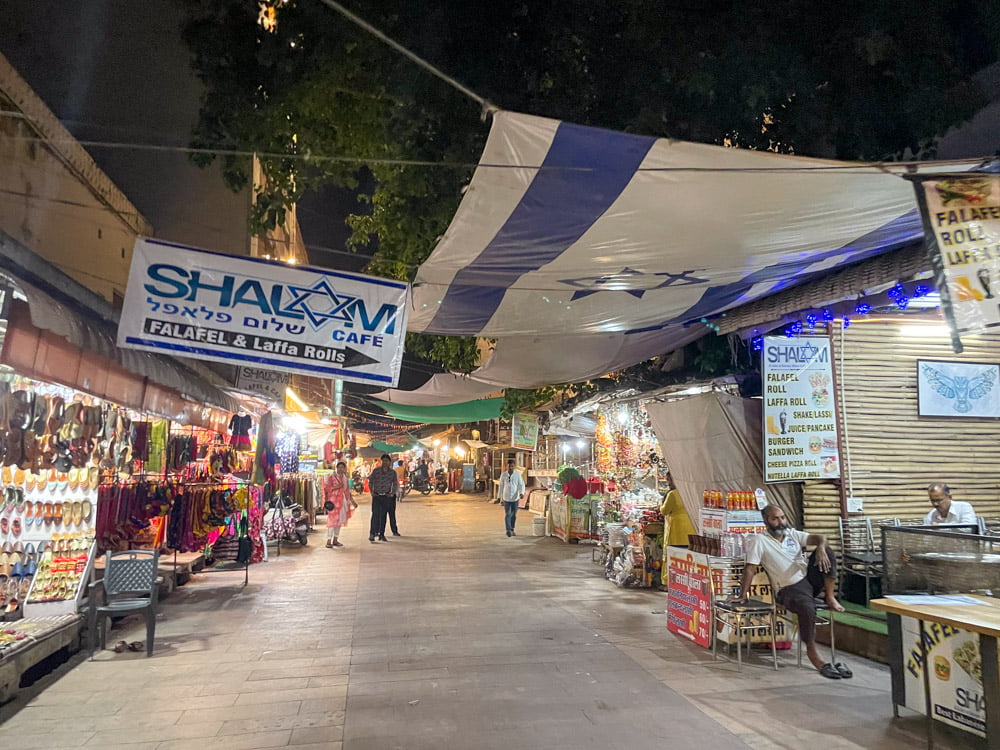
Recommendations for exploring Pushkar
Pushkar is in central Rajasthan, on the western slope of the Aravalli Mountains. If you plan to travel from Delhi, the city is about 420 kilometres away. You can reach Pushkar from Delhi by car in about seven hours. The nearest airport to Pushkar is Ajmer, which you can also reach by train. India has an excellent railway network, with frequent buses reaching areas not served by trains.
However, despite being a lover of independent travel, for my Rajasthan tour, I chose to travel in a chauffeur-driven, air-conditioned minibus because it was my first trip to India. I recommend this as the best way to explore Rajasthan. India can be so intense that I needed to discover it with a tour guide who could explain the cultural differences.
Regarding Pushkar, consider it a relatively small town, and you can easily see all its attractions, including the market, in one day. On an organised trip like mine, or by hiring a car with a driver (I advise against driving in the absurd Indian traffic), you can arrive in the evening, stroll and shop the market, enjoy a characteristic vegetarian dinner at the hotel and devote the next day to visiting the temples before leaving.
If, on the other hand, your stay in Pushkar coincides with the Festival in October-November or the smaller cattle fair in March, extend your stay to immerse yourself in the city’s unique atmosphere. During these events, its appearance changes completely. The Pushkar Festival period is also an important pilgrimage time for Hindus, who come in even greater numbers to the sacred lake and the nearby Brahma Temple to express their devotion.
Pushkar handicrafts: what to buy and how much souvenirs cost
Pushkar is a great place to buy souvenirs during your trip to India. Even outside the festival period, the Pushkar market remains one of Rajasthan’s most authentic and fascinating. However, despite a few exceptions, many products are of medium-low quality, especially the traditional bangles, often made of plastic instead of glass. If you are looking for quality jewellery and costume jewellery, you may find a better selection in Jaipur.
The market around the Brahma Temple remains open until late evening, allowing you to explore and shop after dark. Prices are generally low, much cheaper than other Rajasthan cities I have visited, and you can find some lovely, inexpensive gifts to take home, such as T-shirts, bags or Indian-style clothes.
The prices are pretty reasonable. For example, a crocheted bag sells for ₹650, a price in Indian rupees that corresponds to about €7, while a skirt or T-shirt costs only ₹200, or €2.5 at the time of writing. If you like handmade leather and fabric sandals, they cost just €1 more. The challenge is just finding a Western size. In India, people are also expected to haggle over price, so, as our guide explained, don’t hesitate to negotiate to get a better price.
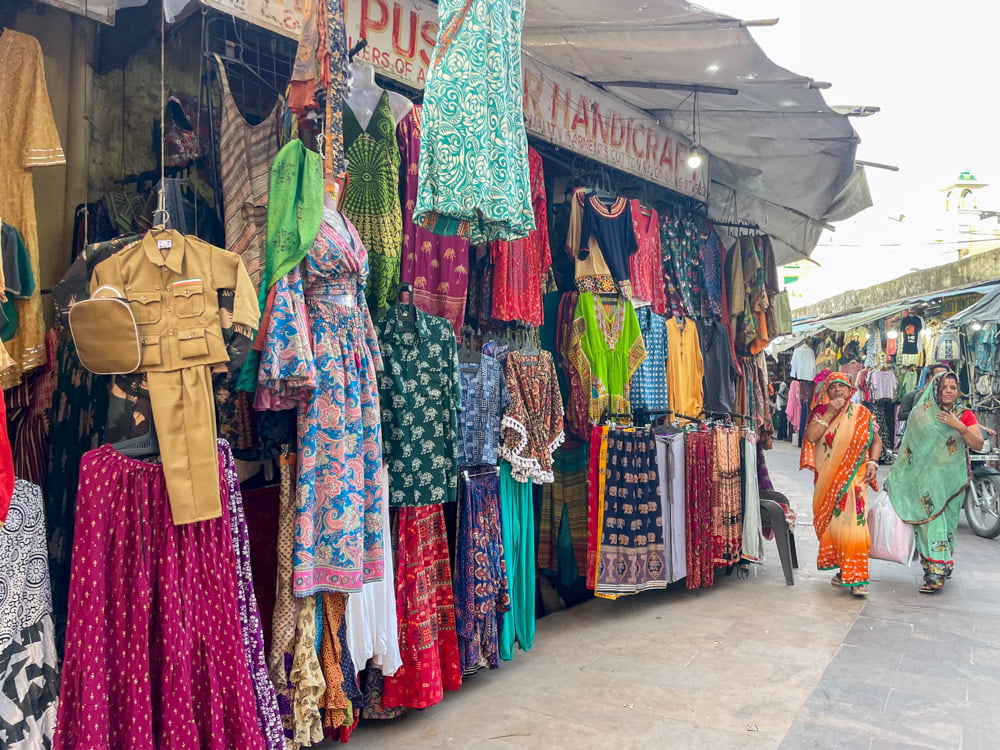
How to avoid tourist traps
The Pushkar market area is relatively safe to wander around on your own but keep in mind that it is still a tourist town. You can find scammers around, especially around the temple. So watch out for people who try to sell you products at exorbitant prices or scam you in other ways, for example, by selling you tickets to the Brahma Temple, which is free.
Where to sleep in Pushkar: Kothi Pushkar
During my visit to Pushkar, I stayed in the lovely Kothi Pushkar Hotel, which I highly recommend for its traditional atmosphere coupled with Western service and cleanliness standards. The basic rooms, called Deluxe King, are elegantly furnished with traditional Indian furniture, are spacious and air-conditioned, with complimentary Wi-Fi. They cost around ₹3,000, about €33, and are probably negotiable in low season.
The hotel also offers suites with living rooms and family rooms if you prefer larger accommodations. Please note, however, that at the time of our visit, the single rooms in the family suite did not have air conditioning, although it was planned to be installed. If you are in a group and would like adjoining rooms, I recommend asking for confirmation regarding air-conditioning, especially if you plan to stay during intense heat.
As for meals, the Kothi Pushkar Hotel has a restaurant where you can have breakfast or enjoy an authentic Indian vegetarian dinner. Like all hotels accustomed to Western tourists where I stayed during my trip to India, the food is not particularly spicy unless specifically requested. That is because they are used to ‘no spicy’ requests, which are essential when it comes to food. In fact, classic Indian home-cooked food tends to be inedible for Europeans because of its spiciness. I have tried it, and I do not recommend it!
Finally, another reason to choose the Kothi Pushkar Hotel is its location within walking distance of the Brahma Temple and the market. It is which makes it very convenient to visit the city’s main attractions on foot.
Kothi Pushkar
Brahma Temple Rd
Pushkar, Rajasthan 305022
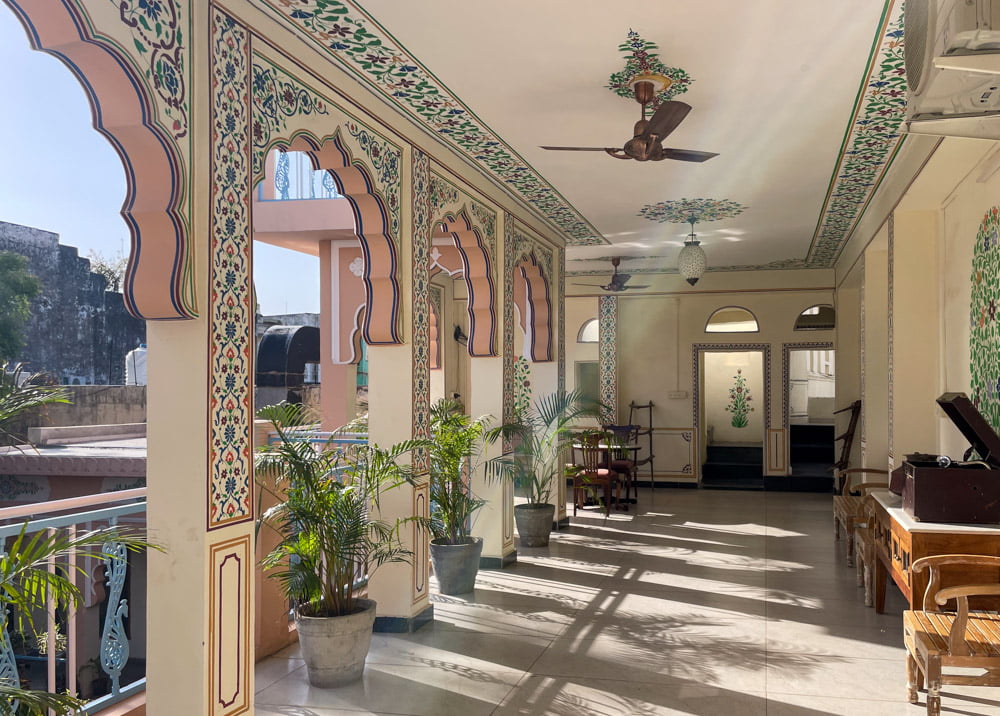
Pushkar: a must-see in Rajasthan
Despite its contrasts, Pushkar is a must-see destination to immerse yourself in the beauty and spirituality of Rajasthan. Outside the festival period, it is not touristy, and you can linger among the market stalls or in the temple without being pestered by nagging vendors. Pushkar is almost a relaxing stop during a trip to Rajasthan, where you can indulge in traditions and good food, admiring the slow lifestyle of more traditional India.
Pushkar in Rajasthan offers a unique experience to discover authentic India. With its bustling market, traditional Pushkar Festival, Brahma Temple, and picturesque Holy Lake, the city is a perfect destination for those passionate about culture and spirituality, or simply looking for a unique place to explore. Feel free to share in the comment if Pushkar has ever enchanted you in Rajasthan or if you are planning a trip after reading my article.
